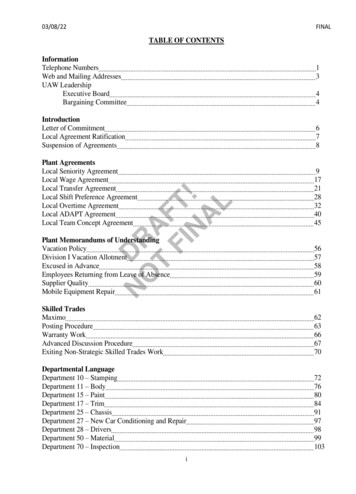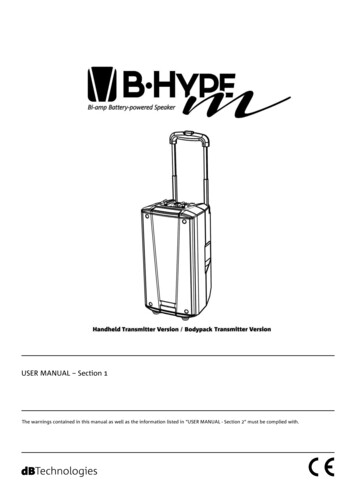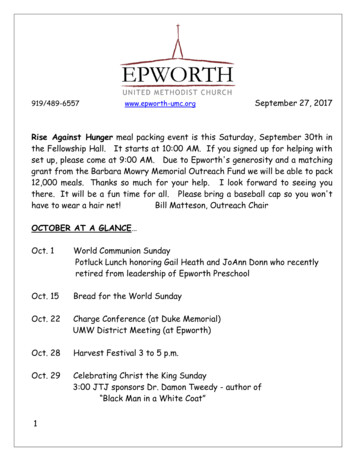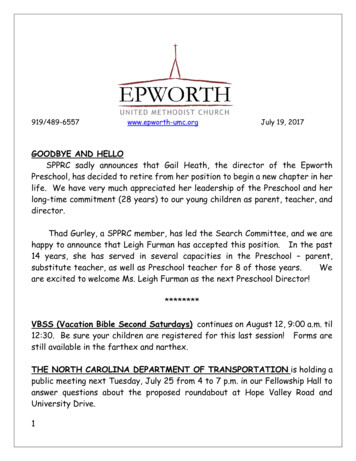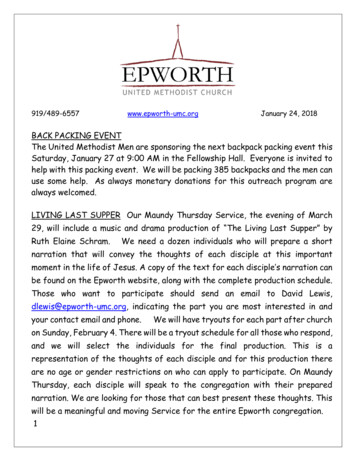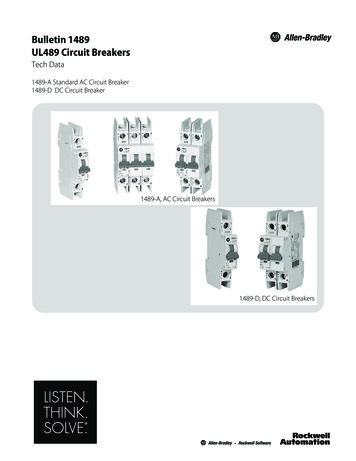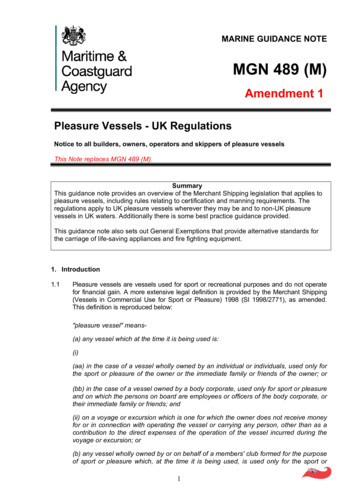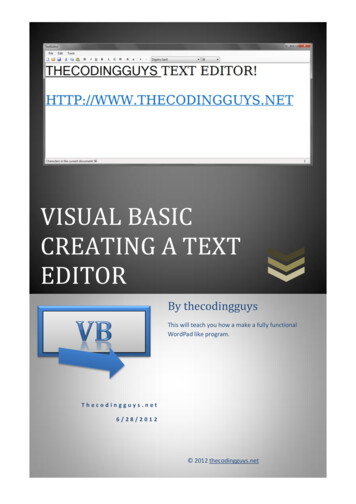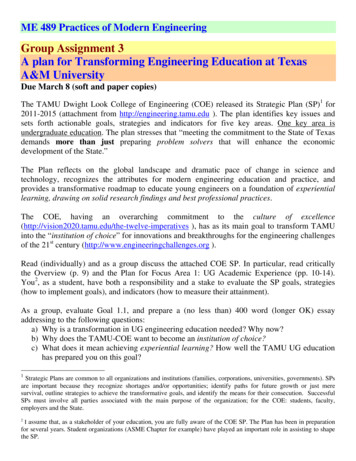
Transcription
ME 489 Practices of Modern EngineeringGroup Assignment 3A plan for Transforming Engineering Education at TexasA&M UniversityDue March 8 (soft and paper copies)The TAMU Dwight Look College of Engineering (COE) released its Strategic Plan (SP)1 for2011-2015 (attachment from http://engineering.tamu.edu ). The plan identifies key issues andsets forth actionable goals, strategies and indicators for five key areas. One key area isundergraduate education. The plan stresses that “meeting the commitment to the State of Texasdemands more than just preparing problem solvers that will enhance the economicdevelopment of the State.”The Plan reflects on the global landscape and dramatic pace of change in science andtechnology, recognizes the attributes for modern engineering education and practice, andprovides a transformative roadmap to educate young engineers on a foundation of experientiallearning, drawing on solid research findings and best professional practices.The COE, having an overarching commitment to the culture of mperatives ), has as its main goal to transform TAMUinto the “institution of choice” for innovations and breakthroughs for the engineering challengesof the 21st century (http://www.engineeringchallenges.org ).Read (individually) and as a group discuss the attached COE SP. In particular, read criticallythe Overview (p. 9) and the Plan for Focus Area 1: UG Academic Experience (pp. 10-14).You2, as a student, have both a responsibility and a stake to evaluate the SP goals, strategies(how to implement goals), and indicators (how to measure their attainment).As a group, evaluate Goal 1.1, and prepare a (no less than) 400 word (longer OK) essayaddressing to the following questions:a) Why is a transformation in UG engineering education needed? Why now?b) Why does the TAMU-COE want to become an institution of choice?c) What does it mean achieving experiential learning? How well the TAMU UG educationhas prepared you on this goal?1Strategic Plans are common to all organizations and institutions (families, corporations, universities, governments). SPsare important because they recognize shortages and/or opportunities; identify paths for future growth or just meresurvival, outline strategies to achieve the transformative goals, and identify the means for their consecution. SuccessfulSPs must involve all parties associated with the main purpose of the organization; for the COE: students, faculty,employers and the State.2I assume that, as a stakeholder of your education, you are fully aware of the COE SP. The Plan has been in preparationfor several years. Student organizations (ASME Chapter for example) have played an important role in assisting to shapethe SP.
d) What are the planned activities for students to gain critical thinking? How well thecurrent UG education has prepared you on this aspect?e) Why is engagement in “research” important in a transformative UG education?f) Why is important to learn how to learn? And how to assess (measure) a commitment tolifelong learning?g) Does the SP gives the means or specifies how (in terms of credit hours) thetransformative education will take place?a) As a corollary, how as a practicing engineer you will help TAMU, your alma mater, toeducate effectively students (perhaps your own children) to meet contemporarychallenges, be prepared for global competitiveness, create innovations and producediscoveries, etc.Your lecturer; not only a teacher, but also a former student, a parent and an employer, hasparticular interest in learning your informed opinion on how you see your own education andthat of generations to come.The assignment intends to make you aware of institutional challenges and changes; and for youto participate in their implementation.Thanks for your attentionLuis San AndrésMEEN 489 Lecturer
THE BETTER TEAMThe constant evolution of technology today requires that any engineering program improveand transform itself in order to keep from falling behind. This is especially true of undergraduateprograms, the starting point for the majority of the world’s engineers. With advancements incomputers and more competition from other countries, “traditional” U.S. engineering jobs ofcrunching numbers and making basic decisions will be replaced. Literature earlier this semesterpointed to the quick, cheap production of engineers with great technical skills across Asia.Skilled technicians like this require the meaning of the term “engineer” to take on a moreimportant meaning: someone who not only has the necessary technical skills, but can also applycritical thinking, interpersonal skills, and business savvy to advance themselves, their company,and their country. The present teaching format is quite frankly unable to keep up with the realworld and students need to be challenged to “develop content mastery in the context ofcompelling real-world environments” [1]. The focus on grades and repetition in some classescan require very little thinking from students. Engineers now must be able to think on alarger scale and be able to readily convert science into practical solutions to current orforthcoming problems. If Texas A&M, as a university, doesn’t embrace the changing times, itseducation, and therefore the engineers it produces, will eventually become obsolete.Furthermore, if we, as future engineers, don’t ensure that we will engage in lifelong learning, ourjobs will be in jeopardy for the same reasons.The Dwight Look College of Engineering is committed to becoming an “institution ofchoice” in developing the “innovations and breakthroughs that address the engineeringchallenges of the 21st Century” [1]. The easy problems have been solved; it is the “GrandChallenges for Engineering” as stated by the National Academy of Engineering that are essentialfor future engineers to tackle. These “Grand Challenges” push engineers to make solar energyeconomical, prevent nuclear terror, reverse-engineer the brain, provide access to clean water, anddevelop many more world-improving innovations. Texas A&M University also wants tobecome an institute of choice so it can grow as a university and attract more high-qualitystudents. Professors want Texas A&M University to become more prestigious not only for them,but also because they see a need for better education.Experiential learning involves being challenged with real world scenarios and having theopportunity to invest time into solving a real problem, a strong focus at Texas A&M.Experiences in labs and classes have provided a solid foundation of experimental learning. Mostlabs are productive, allowing students to see real world applications of the technical contenttaught in lectures. The many team-based projects undoubtedly assist in developing cooperativeskills that are needed in the work place. Presentations allow for students to practice publicspeaking. Unfortunately, design classes and electives that allow focused innovation areunavailable to students until their later college years. Enabling earlier forays into innovationcould allow students to focus on learning about topics and developing skills they prefer to focus
on, setting the stage for developments by current engineering students and recently-graduatedengineers.Planned activities to increase critical thinking include more hands-on courses, incentivesfor professors to develop the course, mentorships between upperclassmen and underclassmen,create open-ended assignments, improved classrooms, and resources that support innovativelearning [1]. The courses and material do not determine the critical thinking required bystudents, but the professors do with the problems they create and the commitment they make toshow the application of their particular topic. The idea of creating a “thick spine ofexperiential learning” by adapting earlier courses to encourage creativity and criticalthinking is a noble goal, but seems unrealistic. Most professors already seem to struggle toteach all of the information required and adding “experiential” work may hinder themfurther. A class that has already been compressed to fit in more material, MEEN 260, is a bitoverwhelming and disliked by most students. Introducing more engineering-based courses earlycould be beneficial, but it shouldn’t compromise a solid technical foundation. A transformationin TAMU Engineering to conform to today’s society may create a need to extend anundergraduate degree to more than 4 years. However, developing an education-focused corefaculty, creating teaching mentorships by upperclassmen, challenging students to critically think,and make decisions will enhance the education at Texas A&M University.Research is certainly important for technological advancements and pulling together thetopics learned in classes and addressing a real life problem. Goal 1.1 encourages education basedon “solid research findings”. While the basics of engineering that are currently taught to allengineering students are based on past research, very little comes from new developmentsin the engineering world, let alone research performed by our own professors. By increasingthe focus on new innovations and mentor relationships between students and teachers, TexasA&M can produce engineers who are familiar with research and development, and are ready toapply that experience to the engineering world.To help other students and the Aggie family, alumni can emphasize the importance ofcontinued education and maintaining an awareness of one’s surroundings. Although it isimportant to know your technical field, of equal or more importance is recognizing how theworld around you is changing, what you need to do to maintain your job, and meet new needs.By utilizing the Aggie network, engineering programs can bring in successful graduates whohave used their schooling and experience to encourage new advances in technology.Demonstrating how the hard work required of engineers can pay off will serve as motivation forstudents to revolutionize the modern world.[1] Dwight Look College of Engineering 2011 – 2015 Strategic Planning Committee,“Strategic Plan 2011-2015”. Fall 2010 pg. 8-18
team Wrecking CrewTransforming Engineering EducationIn 1997 when President Ray Bowen was responsible for “Vision 2020”, Texas A&M(TAMU) started investing heavily in transforming the Dwight Look College of Engineering(COE). A strategic plan (SP) was developed by the COE to outline these objectives:undergraduate academic experience, graduate academic experience, research portfolio, facultyand staff development, and K-14 Engagement[1]. This paper focuses on the undergraduateacademic experience.A transformation is needed in undergraduate (UG) engineering education to keep up withthe fast-paced world and technology. It is needed now, because during the past few decades, theway corporations do business has drastically changed to a global environment and TAMUengineers need to adapt to this new environment. TAMU-COE also wants to become an“institution of choice[1].” This means that instead of many students choosing TAMU for itsvalue and non-rigorous admission, the COE wants students to come because of the top quality ofeducation that students will receive.An “experimental learner” must be involved in the practical problems and learn from theexperience gained from these problems. The TAMU UG education has not prepared its studentswell, because the labs associated with classes do not do a good job relating their objectives toreal world problems. Also, when there is a lab, the experiment it is often well defined andalready set up to run. Planned activities for “critical thinking” are more hands-on courses fromstart to finish in the engineering curricula. This would require real word applications to beintegrated with classroom material. The current UG education has not prepared its students wellon this aspect, because almost all of the problems are well defined and there is only one solution.
Senior design classes are a good step forward, but more labs and courses need this approach toreally help students engage in critical thinking.Engagement in “research” is important in a transformative UG education, because itprovides students with hands-on experience, inspires UG students to become graduate students,promotes critical thinking, and will help set TAMU apart from other universities. It is alsoimportant to learn how to learn since innovations throughout the world are happening at anincreasingly fast rate. If engineers are to keep pace with this current trend they will be requiredto enhance their knowledge and skills throughout their careers. An engineer’s lifelong learningwill be assessed by their employers and how well they are advancing in their career.Next, the SP references the possibility of an endowment to fund the development ofhands-on courses. These courses would be evaluated by UG students to gauge the effectivenessof the enhancements. It is important for a practicing engineer to impart the skills learned in theirjob to students to help develop their education and encourage them to learn. In order to helpthese students, practicing engineers should volunteer to either teach classes or give presentationson their jobs. Students will learn from these engineers the expectations in the work force.Texas A&M University is always trying to enhance the education it gives students andwants to be an institution that students think of when they think of top quality education.Therefore, a SP is needed to define what direction the COE wants to go and it continually needsto be refined just like an engineer needs to be engaged in lifelong learning.
References[1] Srategic Planning Committee Members “Strategic Plan 2011 – 2015,” Dwight LookCollege of Engineering, rategic%20plan%202011-2015.pdf (accessed March 8, 2011)
A&M TEAM Technology is rapidly changing and new graduates need to not only keep up with the fast pace,but be faster so they can contribute to new discoveries and innovations. A&M wants to produceengineers who can benefit society with both their discoveries and strong work ethics. Americanengineers are more expensive to hire than others so they need to find ways to justify the extra expense.A&M wants to foster a mindset for critical thinking. To do this the engineers need to be able todo more than solve isolated problems. Engineering education needs to be about more than technicalskills, it needs to encompass the broader skills to implement new technologies and ideas in a timelymanner. The education reform wants to link discovery and application. A&M wants to become the‘institution of choice’ for researchers because it has the best opportunities.Experiential Learning is referring to a method of learning through direct experience. Themotivation behind this change in engineering education is to provide a “thick spine” of experientiallearning throughout all four years of student’s education. Currently I feel that the Mechanicalengineering program is lacking in this area. Only the last year of my education has been real worldapplication and experiential learning.Several activities that are planned to enhance students critical thinking are mentorshipprograms, open ended design problems, and more hands on courses. The desire is to promote programsfor upperclassmen to present demonstrations in class that provide a physical understanding. Moredesign problems will allow students to think more creatively and apply skills they have learned. Morehands on courses will allow students to learn at a deeper level. Overall the current undergraduateprogram has promoted critical thinking but could use more design problems and more hands oncourses.Only a select few on engineering careers will actually use knowledge such as “Mohr’s Circle” and“three degree‐of‐freedom dynamic systems.” The goal of an education is not the procedural methodsused in the corporate world. Engineering is much too broad to cover in a four‐year education. Instead,undergraduate study teaches students how to “learn to learn.” Learning does not conclude upongraduation. Engineers should be committed to lifelong learning. Schools can help foster this idea bydeveloping the students’ passion for engineering in classes such as Special Topics in Engineering.Undergraduate research, however, provides an opportunity for undergraduate students todevelop the “thick spine.” Although professors are pushing to emphasize higher steps in the Bloom’sTaxonomy, much of the graduate research is focused on the lower levels of “knowledge” and“understanding.” Undergraduates typically do not go as deep into the field of research as the graduatestudents do, but research allows the undergraduates to be exposed to the higher levels of thinking,including “applying,” “analyzing,” and “evaluating.”The main problem that the Strategic Plan seems to run into is in its vagueness in terms ofimplementation. The ideas presented are definitely sound. However, where does one begin? Thereneeds to be a set start point of which classes will be the first to be added, deleted, or changed in some
way. Teachers, while pushing innovation, seem to get stuck in their old ways and do not like to bechanged. The exact changes have to be set in stone for them to truly ever happen. There needs to be aset plan of exactly which classes in what way will be changed for anyone to look at the plan as morethan a good theory that is un‐implementable.Once I become a practicing engineer I plan to help my alma mater by giving back in every way Ican. Financially is one obvious choice, but more importantly I plan to give back by donating my time. Iwould love the opportunity to come back and talk to the undergraduate engineers about the real worldand possibly make a difference in their plans for their future in engineering fieldsWorks CitedBennet, G. Kemble. Strategic Plan 2011‐2015. Publication. Texas A&M University, Fall 2010.Web. http://engineering.tamu.edu .
MEEN 489Team Alpha2The TAMU Dwight Look College of Engineering released its Strategic Plan for 2011‐2015. TheStrategic Plan identifies key issues and sets actionable goals, strategies and indicators in five key areas[1]. One key area is undergraduate education. This paper seeks to address the many questions that haverisen in regards to the Strategic Plan.A transformation in undergraduate engineering education is needed because research hasshown that engineering abilities are developed through practice with feedback. Application of creativeskills such as design and innovation needed in the "real world" are no always nurtured and emphasizedin the traditional academic model. Through the "spine" of courses engineers take from freshman yearuntil graduation, the University wishes to better prepare the students for post‐college opportunities.The Texas A&M College of Engineering wants to become an institution of choice because of theexposure and benefits it brings. Increasing the college’s prestige among other universities in the worldwill allow it to attract better students and faculty. With this increase in talent the university hopes togenerate more revenue and become more renowned for developing innovations that shape the future.Why not strive to be the best?Experimental learning can be defined as learning through experience. The goal of achievingexperimental learning can be accomplished through the observation and utilization of engineeringprinciples in real world applications. The TAMU UG program does a good but not great job of creating anenvironment that promotes experimental learning. Labs give students the chance to use equipment andprinciples learned in class, but they are usually tedious and uninteresting. Creating more interestingassignments will help spark students’ interests and encourage learning.Critical thinking, as an engineer, involves knowledge of theory, reasoning, innovation, clarity andunderstanding of implications. Texas A&M University uses dilemma‐based and scenario‐based problem‐solving with student teams, assisted by simulations and demonstrations, to promote critical thinking.Planned activities for students to gain critical thinking include; student‐supported and –reviewed grantprograms for hands‐on courses, course assignments formatted to allow the student to define theproblem before creating the solution and supplying physical space, such as labs and machine shops thatsupport ideation, analysis, quantifying results and developing creative solutions. [3] I believe that thecurrent undergraduate education has significantly prepared me for the critical thinking challenges facedin industry. For example, MEEN 381, MEEN 489 and ENGR 482 expose students to problems currentengineers face and how to obtain solutions [2]. In MEEN 404 students had to identify a problem,develop their own experiments and analysis to produce results. All the labs, for instance MEEN 464 and364, allow students to use critical thinking to solve open‐ended application‐based problems. In MEEN
MEEN 489Team Alpha3401 and 402 we are exposed to real‐world problems and have to work as a team to develop solutions.The combination of the mechanical engineering curriculum has properly developed our critical thinkingskills.Engagement in research is important in a transformative UG education because it providesstudents educational experience no matter which profession they choose, especially students who maypursue graduate studies and a research career. By having assessments to measure “achievement ofprofessional skill and competencies,” students will be able to understand the importance of learninghow to learn; that every class taken each semester is another progressing step of preparation forengineering in the real world. With skill and competency surveys, students will be able to easily see theirprogress and realize how they have better “learned to learn” throughout school. With such a large jobmarketplace, it is impossible to prepare every student for every profession, thus learning how to learnand being able to apply this to the real world is important for each individual and an essential part of thestrategic plan. Practice with such learning outcome surveys will allow graduates to be able to apply thissame assessment concept throughout the rest of their lives, and be able to measure how theircommitment to lifelong learning has advanced at any time.Goal 1.1 of the Texas A&M Universities Strategic Plan involve the transformation and creation ofa “spine” of courses throughout the entire degree plan of an engineering student that is heavily focusedon experimental learning. This involves a lot of real‐life, hands‐on type of problem solving that is to beimplemented into the current degree plan for Texas A&M Engineering Students. Within Goal 1.1, theplan never states the specifics in terms of actual credit hours and specific courses that will be insertedinto the degree plan. However, the goal does go into slight detail describing that this transformation willinvolve both completely new courses as well as the modification of older courses to fit the changingneeds of the modern engineer. Based on this description, it can be assumed that the current degreeplan used today will see an increase in the number of hours required by the degree plan once the newcourses that will help create this “spine” are introduced here at Texas A&M.Once we all become former students and Texas A&M Alumni members, there will be many waysfor us to support and aid our former school in educating the future engineering students. One of theways that we can do this is to come back and speak to the students in person like many other formerstudents and aggie engineers have come back to do for us in the MEEN 381 course. The course isrequired of all students and consists of a weekly presentation from a former student or practicingengineer giving his/her advice to all of the soon to be former students and practicing engineers. Anotherway that we can help the department is to get involved with the Mechanical Engineering department
MEEN 489Team Alphaand become members of the board that aids in setting and modifying the engineering curriculum asothers have done in the past.Works Cited[1] Bennett, Kemble B. Strategic Plan 2011‐2015. College Station: Texas A&M Engineering, 2010. Print.[2] Department of Mechanical Engineering ‐ Texas A&M University. Web. 08 Mar. 2011. http://www.mengr.tamu.edu/ .[3] Juzaitis, Chair, Ray. "Texas A&M Engineering." Strategic Objectives. (2010): 12‐16. Print.4
Team Classic StyleThe Strategic Plan 2011 20151 (SP) is a stimulating document, in that it tries todetail methods for transforming contemporary engineering education. Specifically, andseemingly more pertinent, the SP identifies ways to “transform” the undergraduateeducation at Texas A&M University.In order to justify this “transformation” in undergraduate education, the SP claimsthat there has been a trend “towards globalization and the creation of a ‘knowledge‐based’economy”. It also remarks on the “shrinking world” and the “global village”, terms that havebecome such prevalent buzzwords in recent times, further describing the globalization ofengineering. As an undergraduate engineer, it is hard to disagree with the thought that theworld economy is more interrelated than ever before. This is especially evident in classesoutside of the Dwight Look College of Engineering, where the idea of a “shrinking world” isaccepted and even lectured on.This makes it necessary that undergraduate engineers receive an education that isbefitting to the “global village.” Swift action is called upon these same engineers whom willsoon be graduating to become something beyond a “tinkerer.”The SP also describes the College of Engineering’s desire to become an “institutionof choice.” In particular, the College of Engineering wants to continue to produceindividuals who can be competitive in today’s technologically dynamic world. Further, itwants to be seen as an institution – rather, to be chosen as the institution – that can providea tier‐one education and experience to people who desire a commitment to “lifelonglearning.”Similar to the ever‐present “shrinking world” notion, experiential learning is anotherphrase that has become quite widespread. It is the idea that learning stems from hands‐onprojects that challenge and enable the student to integrate classroom lessons with projectexperiences. This concept helps students to think of innovative ways to solve theworldwide engineering dilemmas. Many believe there is too much of a gap between theclassroom and the laboratory. For those with experience in undergraduate research, it iseasier to say that “experiential learning” is more easily achievable through research than itis without having participated in research. In that light, if the College of Engineering is toevoke “experiential learning” it must undoubtedly reassess methods for doing so.The SP has designated processes to help in critical thinking, and consequentlyexperiential learning, by proposing a vertically integrated design project that spans acrossthe entire undergraduate experience. While this idea is novel to current engineeringstudents, critical thinking is difficult to procure. The current educational system does notoffer many opportunities for undergraduates to exercise critical thinking skills or evendevelop them, as most classes are structured around books that hardly offer practiceproblems that are comparable to a “real‐world” challenge. Aside from this, a single projectcannot encompass all the variety and conflicts offered in an engineering education. It wouldbe hard to integrate the topics of fluids, dynamics, and materials into one project. Also, itmay be difficult to further learn teamwork skills and compatibility with different people ifthere is only one project to be worked on.Undergraduate research is one way to expose students to “real‐world” challenges.As engineering professors are seemingly cognizant of contemporary engineering issues,they almost certainly are working on ways to combat these issues. Undergraduates shouldtake advantage of these opportunities to proverbially “broaden horizons” while also1
gaining experience in having an employer‐employee relationship with the professor thatcan, at times, emulate the type of relationship found in the “real‐world.”The benefits of undergraduate research also include teaching undergraduates to“learn how to learn.” It challenges undergraduates to look at results and question what theymean and finally (with advisor assistance) to come to conclusions regarding the results.The SP identifies indicators that deem success in this endeavor; in short, altering existingcurriculum to meet contemporary engineering practices through organizational studies,observing engineering education similarities in peer institutions, and positive feedbackfrom students who have completed their education at Texas A&M University1.While the SP is ambitious in the motivation to radically transform engineeringeducation at Texas A&M University, it does not offer a clear plan of how to effectively reachthis goal. While it extends undergraduate research and vertically integrated undergraduateprojects as methods for helping to achieve this “transformation”, it is almost too focused onthe big picture without having devised a structured approach. It even alludes to theaddition of new or the adaption of existing curriculum, it is unclear what should comprisethe “spine” coursework.Finally, as a future engineer, it is important to share the knowledge gained fromreal‐world experiences, as exemplified by David Wisler in his article titled Engineering –What You Don’t Necessarily Learn in School. Further, presentations given by currentpracticing engineers allow for invaluable insight to everything from handling mistakes inindustry to the proper treatment of your coworkers. This kind of knowl
in TAMU Engineering to conform to today's society may create a need to extend an undergraduate degree to more than 4 years. However, developing an education-focused core faculty, creating teaching mentorships by upperclassmen, challenging students to critically think, and make decisions will enhance the education at Texas A&M University.




